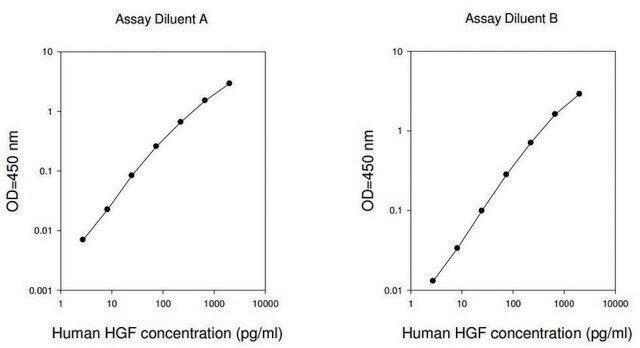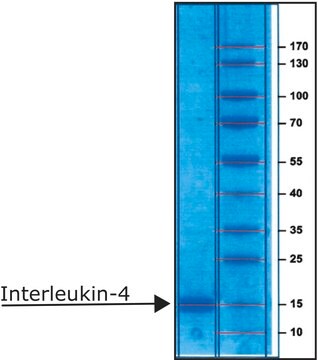RAB0329
Mouse SCF ELISA Kit
for serum, plasma and cell culture supernatant
Faça loginpara ver os preços organizacionais e de contrato
About This Item
Código UNSPSC:
41116158
NACRES:
NA.32
Produtos recomendados
reatividade de espécies
mouse
embalagem
kit of 96 wells (12 strips x 8 wells)
técnica(s)
ELISA: suitable
capture ELISA: suitable
entrada
sample type serum
sample type plasma
sample type cell culture supernatant(s)
assay range
inter-assay cv: <12%
intra-assay cv: <10%
sensitivity: 5 pg/mL
standard curve range: 2.74-2000 pg/mL
método de detecção
colorimetric
Condições de expedição
wet ice
temperatura de armazenamento
−20°C
Informações sobre genes
mouse ... Kitl(17311)
Descrição geral
The Mouse SCF ELISA (Enzyme-Linked Immunosorbent Assay) kit is an in vitro enzyme-linked immunosorbent assay for the quantitative measurement of mouse SCF in serum, plasma, cell culture supernatants and urine.
Imunogênio
Recombinant Mouse SCF
Aplicação
For research use only. Not for use in diagnostic procedures.
Please refer to the attached General ELISA KIT Procedure (sandwich, competitive & Indirect ELISA)
Please refer to the attached General ELISA KIT Procedure (sandwich, competitive & Indirect ELISA)
Ações bioquímicas/fisiológicas
Stem cell Factor (SCF) or kit ligand or steel factor or mast cell growth factor is a growth factor essential to bring about various homeostatic events like maintenance of hematopoietic stem cells, mast cells and melanocytes. SCF is essential for maintaining mature melanocytes and to promote hair pigmentation. In ovary, granulosa cells produce kit ligand, which promotes activation and growth of primordial follicles. Kit ligand converts primordial follicles to primary follicles and leads to subsequent follicle growth. Kit ligand acts as an anti-apoptotic factor and causes the growth of primordial follicles in mouse fetal ovary. Kit signalling is crucial for growth of interstitial cells of Cajal (ICCs) and regulates gastrointestinal motility in fetal mice.
Outras notas
A sample Certificate of Analysis is available for this product.
Please type the word sample in the text box provided for lot number.
Please type the word sample in the text box provided for lot number.
Componentes do kit também disponíveis separadamente
Nº do produto
Descrição
SDS
Palavra indicadora
Warning
Frases de perigo
Declarações de precaução
Classificações de perigo
Met. Corr. 1
Código de classe de armazenamento
8A - Combustible corrosive hazardous materials
Escolha uma das versões mais recentes:
Já possui este produto?
Encontre a documentação dos produtos que você adquiriu recentemente na biblioteca de documentos.
Identification of hair shaft progenitors that create a niche for hair pigmentation
Liao CP, et al.
Genes & Development, 31, 1-13 (2017)
Stem cell factor/Kit signal insufficiency contributes to hypoxia-induced intestinal motility dysfunctions in neonatal mice
Ren H, et al.
Digestive Diseases and Sciences, 62(5), 1193-1203 (2017)
Charlotte B Westbury et al.
Radiotherapy and oncology : journal of the European Society for Therapeutic Radiology and Oncology, 111(2), 206-211 (2014-04-22)
Mast cells are involved in the pathogenesis of radiation fibrosis and may be a therapeutic target. The mechanism of increased mast cell number in relation to acute and late tissue responses in human skin was investigated. Punch biopsies of skin
Kit ligand decreases the incidence of apoptosis in cultured vitrified whole mouse ovaries.
Abdi S
Reproductive Biomedicine Online, 30(5), 493-503 (2015)
Armelle Calipel et al.
Clinical & experimental metastasis, 31(5), 553-564 (2014-03-22)
Imatinib mesylate is used in targeted therapy of cancer to inhibit type III tyrosine kinase receptors, such as KIT and platelet-derived growth factor receptors (PDGFRs). Expression of KIT in uveal melanoma (UM) suggests that this receptor may be the target
Nossa equipe de cientistas tem experiência em todas as áreas de pesquisa, incluindo Life Sciences, ciência de materiais, síntese química, cromatografia, química analítica e muitas outras.
Entre em contato com a assistência técnica









